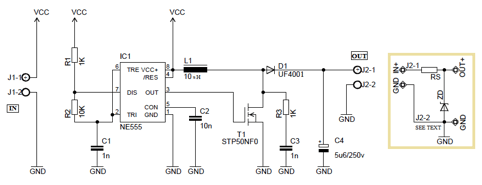
To drive small neon lamps or similar devices in your microcontroller/robotic projects, you need a high-voltage dc power supply for consistent and fast performance. This circuit allows you to make a very simple HV generator for general-purpose applications that require a high-voltage for proper operation. The circuit uses very readily available parts which can be bought from almost any electronics components store.

The circuit is designed around one of the most common ICs in the universe—the 555 timer chip. The 555 (IC1) is configured as an astable oscillator (AMV) which oscillates at a frequency (around 68KHz) determined by the values of components R1,R2,and C1. IC1’s output directly drives a type STP55NF0 high-power mosfet (T1), that switches the current through a 10uH/200mA inductor (L1). The “ultra-fast recovery” type diode and “high-voltage” type capacitor combination (D1 and C4) frames an efficient output rectifier and filter circuit,while R3-C3 forms a snubber network for T1.
Well, there is not much to say about the construction, just get the components in their appropriate places and the right way around on a piece of perfboard. When you have checked your work, you can then give the finished unit a pre-flight test. Just connect a 5-6 volt dc source to the input terminal block (J1). Next take your multimeter and check the “raw” output voltage available at the output terminal block (J2). It could be anywhere in 30-90 volt dc range.
Once you get the high voltage output, you can trim it for real-world applications, by adding an optional simple zener diode – based shunt regulator circuitry as indicated in the circuit diagram. Note that the final output voltage will vary a bit with connected load, but it should not swing by more than a few volts from 0 to 10mA load.
Warning: This HV generator circuit, while not as dangerous as mains power, still provides enough energy to potential attack a person should they be connected between the high voltage output and ground in the right way. So be very careful when working on this circuit!

The shunt regulator maths
Assume that the raw output voltage is 50V, and what you actually looking for is 1mA at 27V. Then you should use a 27v zener diode as ZD, and calculate the value of series-resistor/ballast resistor (RS) using the formula RS = Vin-Vreqd/Ireqd (here in this case, it is 50v-27v/1mA).
Finally, note that, this is a basic design idea for electronics hobbyists. Interested readers can modify the circuit by changing the operating frequency of the 555 IC, and/or altering the values of output components like the inductor, mosfet, rectifier and filter capacitor, etc. to get desired results!












